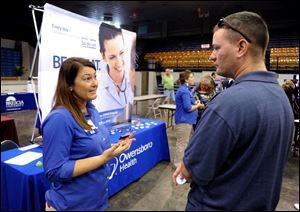
Hiring slows in September
U.S. employers add 148K jobs; unemployment rate falls to 7.2 percent
10/22/2013
Registered nurse Salanda Bowman, left, talks with part-time Kentucky Wesleyan College student Jason Ward, of Whitesville, about job openings at the Owensboro Health Regional Hospital during a Regional Career and Job Fair in the Owensboro Sports Center in Owensboro, Ky. earlier this month.
WASHINGTON — U.S. employers held back on hiring in September, a discouraging sign that the job market was weakening before a 16-day partial government shutdown began Oct. 1.
The Labor Department said the economy added just 148,000 jobs last month, a steep drop from the 193,000 created in August.
Still, the gain was enough to lower the unemployment rate to 7.2 percent from 7.3 percent in August. Unemployment remains historically high but is near a five-year low and is down from 7.9 percent at the start of 2013.
The tepid job growth makes it more likely that the Federal Reserve will maintain its level of bond purchases for the rest of this year. The bond purchases are intended to lower long-term interest rates and boost borrowing and spending. They also tend to boost stock prices by encouraging investors to dump low-yielding bonds in favor of riskier assets.
The release of the September jobs report had been delayed 2½ weeks by the shutdown, which likely further slowed economic growth and hiring. Temporary layoffs of federal workers and government contractors will probably depress October’s job gain. That means a clearer view of the job market may not emerge until the November jobs report is issued in December.
“The economy is too fragile for the Federal Reserve to touch,” Sung Won Sohn, an economist at California State University, said. “The shenanigans in Congress have hurt confidence and increased uncertainties, most likely hurting both consumer and business spending as well as hiring.”
Average U.S. job growth has fallen sharply in the past three months after a promising start this year. The economy has added an average of 143,000 jobs a month from July through September. That’s down from the 182,000 average gain during from April through June and well below the 207,000-a-month pace from January through March.
The report “reinforces the impression that the labor market was losing a little momentum heading in to the shutdown,” said Josh Feinman, global chief economist at Deutsche Asset and Wealth Management. “The labor market is continuing to create jobs. ...It’s just frustratingly slow.”
Stocks, however, surged after the report was released, likely because slower job gains mean the Fed will continue its stimulus efforts. The Dow Jones industrial average rose 60 points in midday trading.
Economists at Barclays now predict the Fed won’t trim its bond purchases until March, much later than its previous forecast of December.
A tight job market has discouraged many Americans from looking for work. The percentage of Americans working or looking for work remained at a 35-year low last month.
The government doesn’t count people as unemployed unless they are actively looking for work. Most of the drop in the unemployment rate this year has occurred because many people have either given up looking or have postponed their job searches by remaining in school.
The September jobs report showed that some higher-paying industries added jobs at a healthy pace. Construction companies, for example, added 20,000.
Transportation and warehousing gained 23,400 jobs, governments 22,000. Manufacturers added 2,000 jobs.
Lower-paying industries were mixed. Hotels and restaurants cut about 11,000 jobs, after strong hiring earlier this year. Retailers added 21,000 positions.
The recent budget impasse didn’t stop Accumold from boosting its workforce. CEO Roger Hargens said the Ankeny, Iowa-based company added workers in September and plans to hire up to 65 new employees in the next few months. Accumold makes components for medical devices, smartphones and other electronic goods and already employs 185 workers.
Hargens says he is seeing more orders from customers who are shifting from Chinese manufacturers to US suppliers.
“There’s a big trend to move manufacturing back to the United States,” he said. “It’s really speeding up now for us.”
Average hourly pay ticked up 3 cents to $24.09. In the past year, hourly pay has risen 2.1 percent, ahead of the 1.5 percent inflation rate.
The government revised its estimates of job growth in July and August to show a slight net gain of 9,000. It said employers added 193,000 jobs in August, more than the 169,000 previously estimated. But it said just 89,000 were added in July, the fewest in more than a year and below the earlier estimated 104,000.
The deceleration in job growth was a key reason the Fed decided in September to hold off on slowing its $85-billion-a-month in bond purchases. Many economists think the lack of clean data will lead the Fed to put off any decision on the bond purchases until 2014.
“It reinforces their hesitancy,” Feinman said of the September jobs report. “It’s more validation for their hesitancy to taper in September.”
Many economists say the shutdown cut $25 billion out of the economy and slowed growth to about a 2 percent annual rate in the October-December quarter. That’s down from estimates before the shutdown that the economy would expand at a 2.5 percent annual rate.
Robert Mellman, senior U.S. economist at JPMorgan Chase, forecasts that October’s job gains will be lower by about 35,000 because of cutbacks at government contractors and other companies affected by the shutdown. Many of those jobs will be regained in November.
Growth will likely be a bit higher in the first three months of next year, as consumers and businesses make purchases and investments that were delayed during the shutdown.